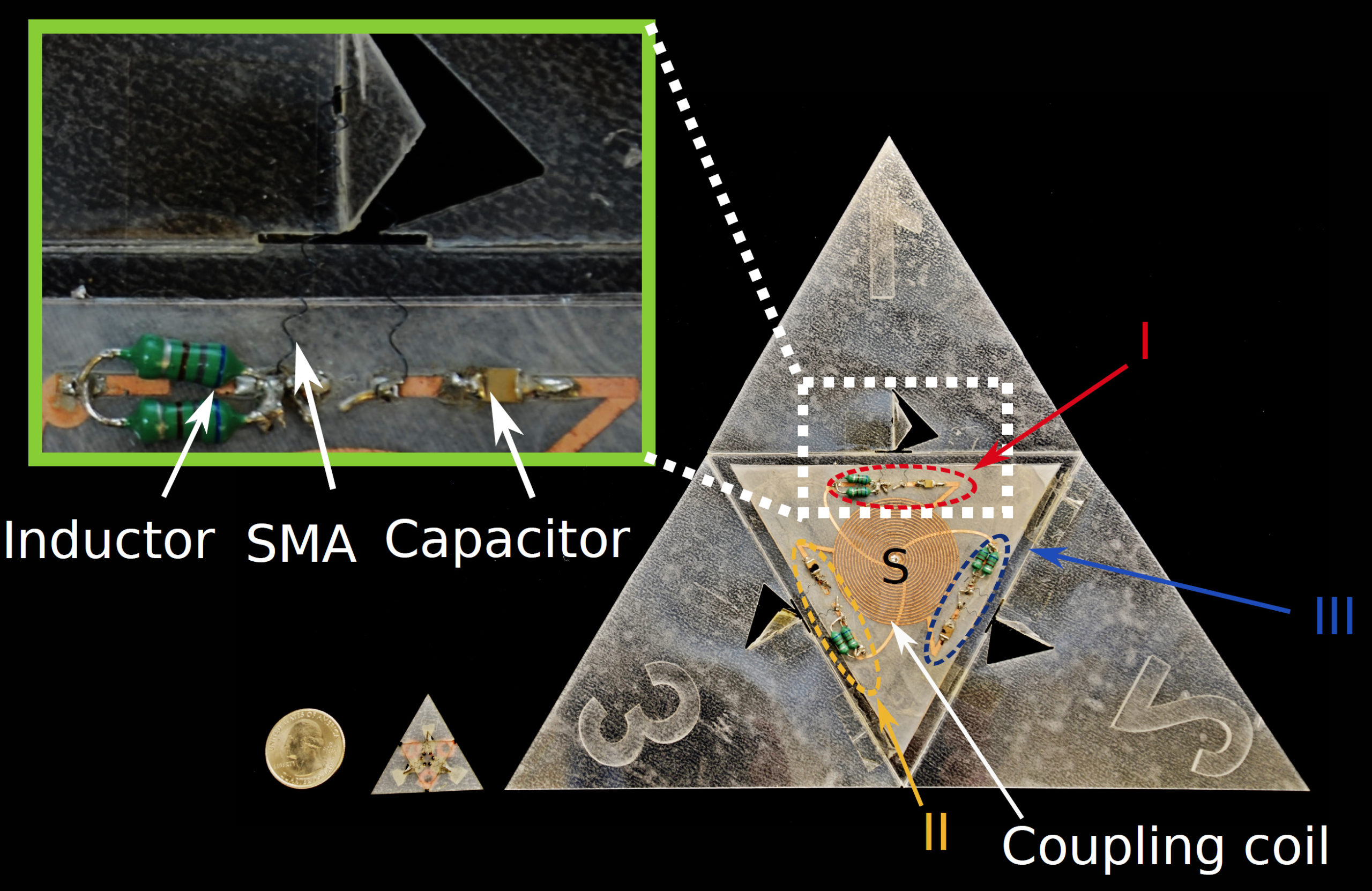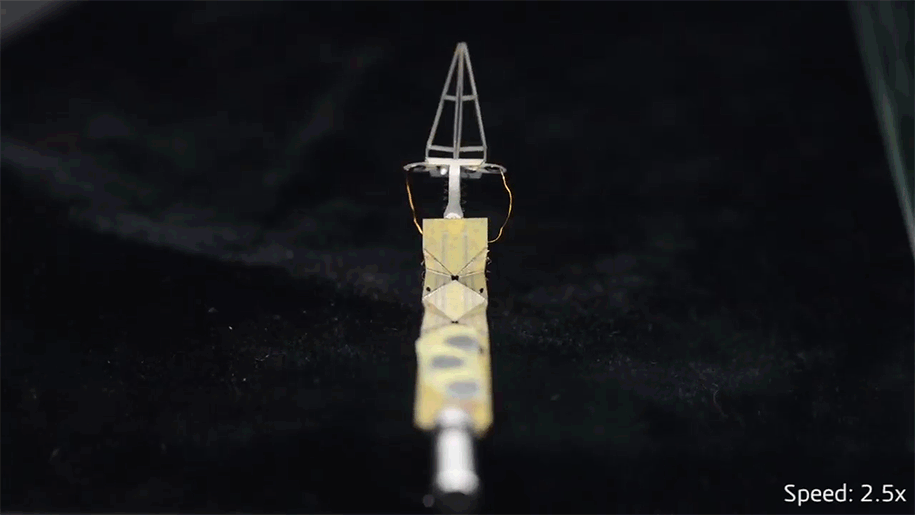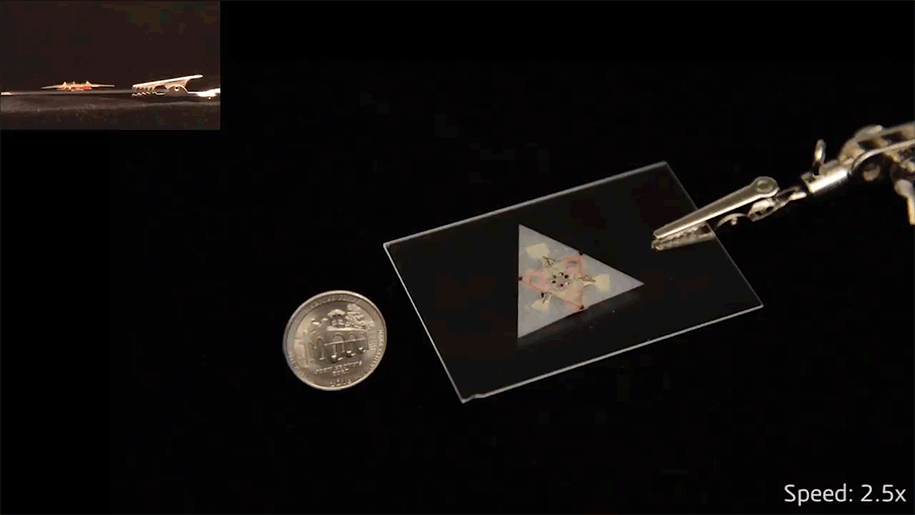Inspired by the traditional Japanese art of origami, self-folding robots can go places and do things traditional robots cannot. A major drawback to these devices, however, has been the need to equip them with batteries or wires. Researchers from Harvard have found a new way to overcome this problem, by designing folding robots that can be controlled using a wireless magnetic field.
Image: Wyss Institute at Harvard University
Folding robots are a funky version of on-demand robotic manufacturing or “printing”, where users can deliver a pre-folded version of their device to an otherwise inaccessible or hard-to-reach environment, and then have it fold into its intended physical configuration after which point it can perform useful work. Trouble is, most complex origami-bots to date have required batteries and wires, making them bulky, heavy and biologically unsafe.
Indeed, one of the more exciting possibilities for self-folding robots is their potential use in medicine. In future, surgeons could deliver a tiny origami-bot into the body, where it could unfold and perform a medical task, such as targeted drug delivery.
The presence of wires and batteries presents an obvious hurdle, which is why a team of researchers from the Wyss Institute for Biologically Inspired Engineering and the John A. Paulson School of Engineering and Applied Sciences (SEAS) at Harvard University decided to create a wireless, externally powered self-folding robot.
Scientists have developed origami-bots and self-folding designs that don’t require batteries or wires, but these designs were rather basic. The new folding bots are a bit more complex in terms of form and potential function.
Led by roboticist Mustafa Boyvat, the researchers designed and demonstrated several systems, including a quarter-sized flat tetrahedral robot (a spherical six-bar origami pattern) and a hand-sized ship robot made of folded paper.
To make these things move without batteries, the researchers installed two structures into their joints: coils of Shape Memory Alloys (SMAs), which return the bot to its original shaped when heated, and miniature circuits that become energised when hit with varying levels of magnetic resonance frequencies.
By changing the frequencies, the robots could be made to fold their joints on demand, and independently of each other. They were even able to fold multiple joints simultaneously by exposing the bots to overlapping electromagnetic frequencies. The team demonstrated multiple degrees of freedom at both centimeter and millimetre scales. This research now appears in Science Robotics.

Image: Wyss Institute at Harvard University
“Like origami, one of the main points of our design is simplicity,” noted co-author Je-sung Koh in a statement. “This system requires only basic, passive electronic components on the robot to deliver an electric current — the structure of the robot itself takes care of the rest.”



The researchers were able to move and unfold the devices without any physical contact, and while the bots were out of visual range.
“We believe that these demonstrations illustrate the viability of collections of wirelessly powered and controlled functional origami robots and devices,” noted the authors in the study. “One potential use involves origami-based medical devices operating remotely inside the human body without the need for energy storage or control electronics.”
Along those lines, the researchers envision a swallowable folding robot that can substitute for an invasive endoscope. Such a machine could move around and perform simple tasks, such as holding tissue or taking video. Excitingly, the highly scaleable design will allow for both smaller and larger versions.
“There is still room for miniaturisation, “said Boyvat. “We don’t think we went to the limit of how small these can be, and we’re excited to further develop our designs for biomedical applications.”
Looking ahead, the researchers plan to experiment with robots of different sizes and physical configurations, and to work with different frequency ranges. As for a folding robot that can assume the appearance of an origami-like swan, the timeline for that is a bit more unclear.
